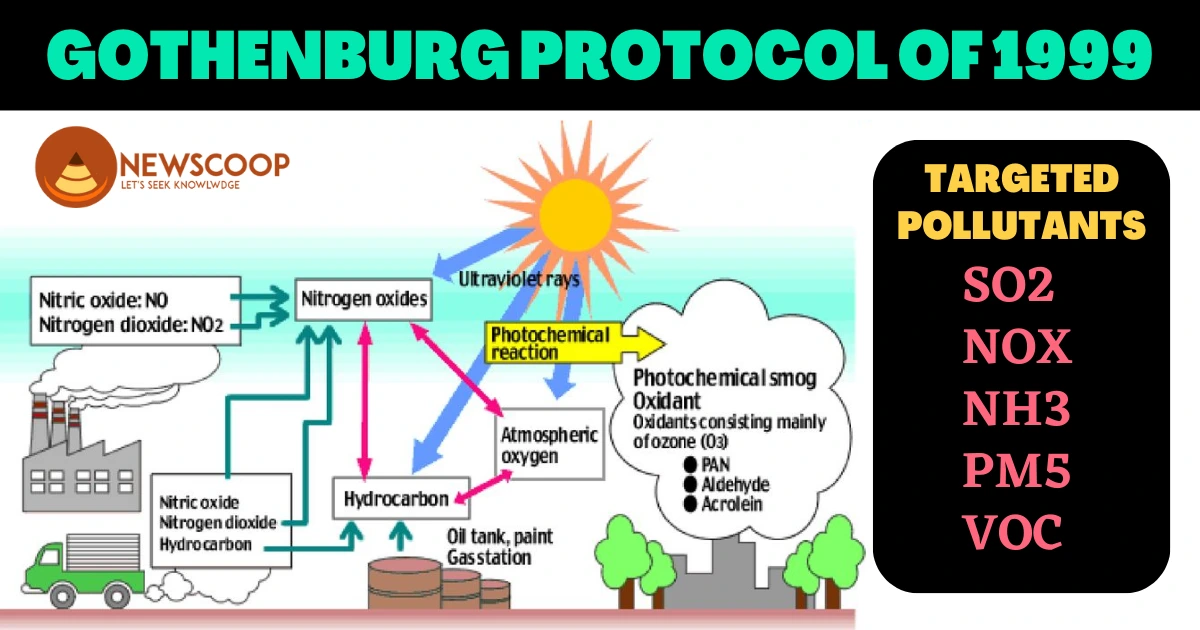Gothenburg Protocol of 1999: Features & Objectives
The Gothenburg Protocol, a cornerstone of international environmental governance, holds the key to addressing critical air pollution issues. In this article, we will dissect the protocol’s core objectives, shedding light on its mission to combat pollution and preserve our fragile ecosystems.
Additionally, we will examine India’s stance on this influential accord, providing valuable insights into the nation’s environmental policy landscape. As we delve into this crucial subject, it’s imperative to emphasize that understanding the Gothenburg Protocol is of paramount importance for UPSC preparation.
What is the Gothenburg Protocol?
The Gothenburg Protocol, officially known as the UNECE Protocol to Abate Acidification, Eutrophication, and Ground-level Ozone, is an international environmental agreement established in 1999. It is a part of the UNECE Convention on Long-Range Transboundary Air Pollution (LRTAP), which aims to address air pollution issues that have transboundary effects.
Targeted Pollutants
The Gothenburg Protocol, a pivotal international environmental agreement, meticulously addresses pollutants that significantly contribute to environmental degradation and public health concerns.
Moreover, its focus lies on combatting acidification, eutrophication, and ground-level ozone formation – all critical environmental challenges. To tackle these issues effectively, the protocol has outlined specific targets for a range of hazardous pollutants.
Here is a comprehensive list of the pollutants targeted by the Gothenburg Protocol:
- Sulfur Dioxide (SO2)
- Nitrogen Oxides (NOx)
- Ammonia (NH3)
- Volatile Organic Compounds (VOCs)
- Particulate Matter (PM5)
Overall, the Gothenburg Protocol represents a concerted international effort to combat air pollution and its detrimental effects on the environment and public health. It stands as a milestone in global environmental governance.
Objectives of the Gothenburg Protocol
The Gothenburg Protocol operates with a three-fold objective:
- Emissions Reduction: By setting legally binding commitments, the Protocol aims to control and reduce emissions of SO2, NOx, NH3, VOCs, and PM caused by human activities. This reduction is essential for mitigating the adverse effects of these pollutants.
- Critical Load/Level Management: The Protocol seeks to ensure that atmospheric depositions or concentrations of pollutants do not exceed critical loads/levels. This is crucial for safeguarding sensitive ecosystems from acidification and eutrophication.
- Prioritizing PM Reduction: The Protocol places emphasis on reducing PM emissions, especially from sources that also contribute to black carbon. This approach not only benefits human health and the environment but also aids in the mitigation of near-term climate change.
Binding Commitments
The Gothenburg Protocol sets legally binding emissions reduction commitments for its member countries. These commitments are aimed at controlling and reducing emissions of the specified pollutants, ensuring that they do not exceed critical levels or loads in the atmosphere.
The protocol was further updated in 2012 to include additional pollutants such as particulate matter (PM) and black carbon.
Scope of the Gothenburg Protocol
The Gothenburg Protocol takes a comprehensive approach to combat air pollution, focusing on a range of hazardous air pollutants:
- Sulfur Dioxide (SO2): Known for its role in acid rain formation, SO2 emissions are regulated to mitigate acidification effects on ecosystems.
- Nitrogen Oxides (NOx): A group of pollutants contributing to both acidification and ground-level ozone formation, NOx emissions are addressed to protect both human health and the environment.
- Ammonia (NH3): This compound, primarily released from agricultural activities, is controlled to combat eutrophication, a phenomenon that disrupts aquatic ecosystems.
- Volatile Organic Compounds (VOCs): These pollutants, originating from various industrial processes and transportation, are regulated due to their contribution to ground-level ozone and photochemical smog.
- Particulate Matter (PM5): The Gothenburg Protocol was updated in 2012 to include PM and black carbon, recognizing their significant impact on air quality and human health.
India’s Position
While the Gothenburg Protocol stands as a testament to international collaboration in environmental protection, it is notable that India has not signed the protocol.
As India continues its efforts to balance economic growth with environmental sustainability, the consideration of such protocols may play a pivotal role in shaping the nation’s environmental policies and practices in the years to come.
Conclusion
In conclusion, the Gothenburg Protocol stands as a formidable international effort to curb air pollution and its far-reaching consequences.
By imposing legally binding emissions reduction commitments, the protocol seeks to control and mitigate the release of hazardous pollutants into the atmosphere. These commitments are not only aimed at safeguarding the environment but also at protecting human health.
Thank You!

